Forums › Laser Treatment Tips and Techniques › Hard Tissue Procedures › Pulsed Nd:YAG for Dentin & Decay Removal
- This topic is empty.
-
AuthorPosts
-
Robert GreggParticipantHi All:
I posted this in the Nd:YAG section as well, but I wanted all the folks interested in “hard” tissue to see what pulsed Nd:YAG users have been doing for over 13 years.
This sort of Class V and tissue prep has been–and still is–routine stuff for us pulsed Neodymium users. We don’t require simultaneous water spray or anesthesia to accomplish this sort of result either.
Just thought all you dedicated hard tissue laser users might appreaciate what a dedicated soft tissue laser can do on dentin and decay using a properly configured laser with optimal (and variable) pulse parameters.
Thanks Big Time to Ron and Glenn for helping me get these images fixed up too! (Ron, I enlarged them to 800 pixels wide to show more detail. I think a happy medium might be 600?)
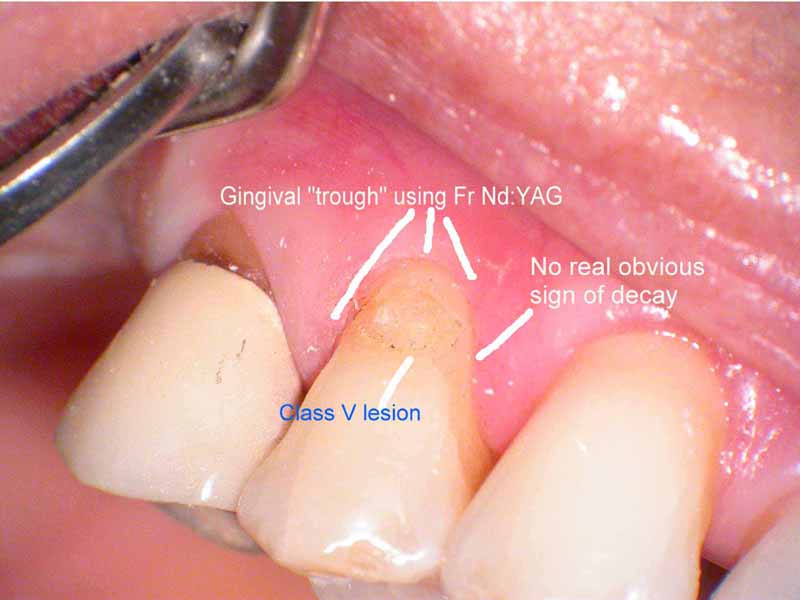
Above Figure: Used 4.0 Watts and 20 Hz, 100 usec PD to trough the gingiva from distal to mesial and accross the facial to expose the margin of the tooth, obtain hemostasis, and control the egress of gingival sulcular fluides.
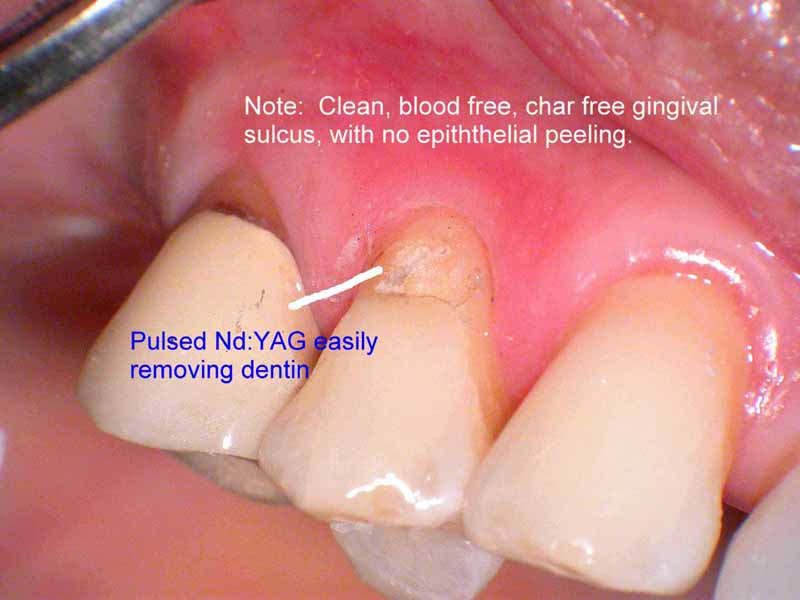
Above Figure: Distal area has been “prepped” using the Fr Nd:YAG at 100 usec, 3.00 watts, 300 millijoules per pulse (mj/p) and 10 Hz. Lasing was done DRY.
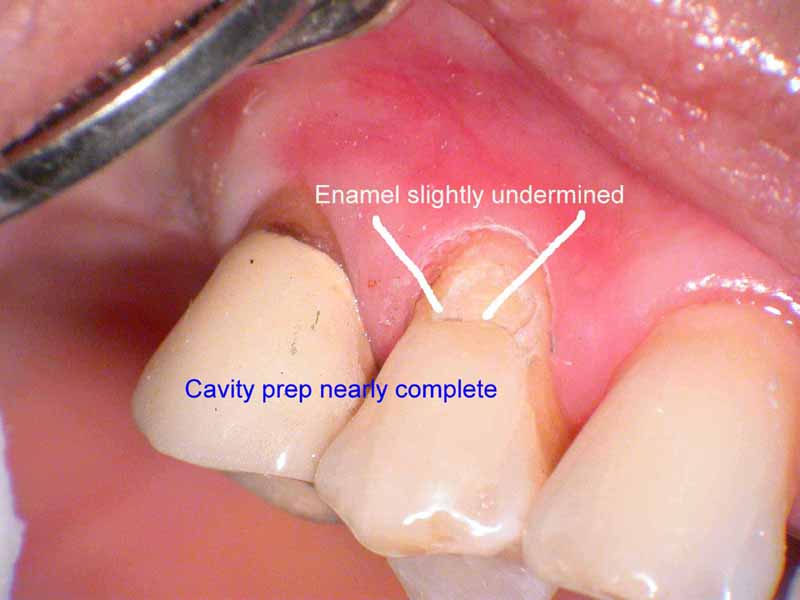
Above Figure: Continue removing healthy dentin, using occasional water spray from the 3-way air water syringe to remove any grey carbon (from plasma) or char that forms on the tooth surface
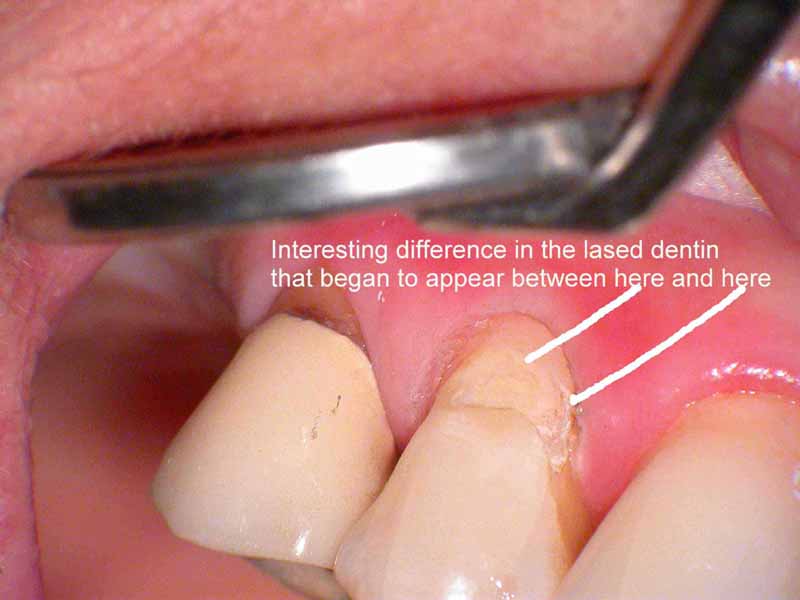
Above Figure: The selective nature of pulsed Nd:YAG–that “sees” different tissues with different tissue constituents, differently–allows for the tissue to ablate and appear different . (Did you follow my thinking on that?) So now we have a different situation than I thought I had at first–which was to do a simple Class V. Now, because of the detection of decay in the dentin due to the pulsed 1064nm wavelength, I have a different scenario AND a different discussion with my patient.
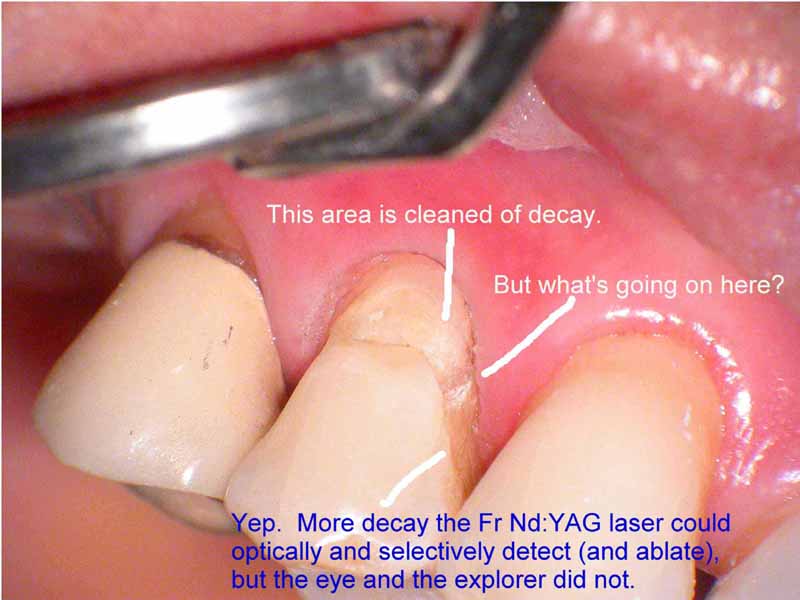
Above Figure: Next to last image (ran out of memory on my card) of my prep before bond and flowable composite with fluoride. Patient informed that a full coverage crown wil be needed if the dentin around the gingiva does not remineralize. Put patient on Prevident 2x’s per day.
Bob
Ps. I’ll get a bigger card ASAP. Hey, I’m a Newbie at photos!
AnonymousInactiveBob, This is a great series of photos that show what we have been doing with the Nd:YAG for many years. New technology not only allows us to see well but to show others what we see. Great post!
SwpmnSpectatorThat’s pretty darn cool. You showed me this on extracted teeth in Anaheim.
How does the 1064nm FR Nd:YAG affect the pulp on vital teeth? Doesn’t the energy penetrate much deeper than my 2780 Er,Cr:YSGG? Did you select a short Pulse Duration in this case to prevent pulpal damage?
Is the fiber in contact with the dentin/caries? Is it possible or would there be any advantages to using a water spray with the FR Nd:YAG?
Al
Robert GreggParticipantHey Al,
Sorry It took me a while to see your post and Del’s–and he’s across the hall fom me, not the country like you are!
How does the 1064nm FR Nd:YAG affect the pulp on vital teeth?
No detrimental effect at all. It will have a pulpal sedation effect like what is talked about with erbiums.
Doesn’t the energy penetrate much deeper than my 2780 Er,Cr:YSGG?
The energy of the Nd:YAG will indeed penetrate much deeper than the Er, Cr:YSGG, but will be transmitted since there is little tissue that will absorb Nd:YAG in a healthy pulp.
Did you select a short Pulse Duration in this case to prevent pulpal damage?
Yes, I chose the shortest I have available to me–100 microseconds.
Is the fiber in contact with the dentin/caries?
Oh yes.
Is it possible or would there be any advantages to using a water spray with the FR Nd:YAG?
Some, but only for removing carbon deposits and keeping the plasma plume down–which causes gray plasma deposition on tooth and soft tissues nearby.
But remember that this wavelength is completely transparent to this 1.064 light and the interaction at the surface would be hindered with water or mist covering the dentin/decay.
Good questions. Thanks for asking.
Bob
SwpmnSpectatorBob:
Thanks for you help here and also with the discussion on hemostasis and pulse duration. I continue to read Manni’s book – these “technical bulletins” you are posting are quite helpful.
Al
-
AuthorPosts
